
Banksia hewardiana is a species of openly branched shrub that is endemic to Western Australia. It has linear, serrated leaves with sharply pointed teeth, head of up to sixty lemon-yellow flowers and oblong follicles.

Gompholobium ecostatum, commonly known as dwarf wedge-pea, is a species of flowering plant in the family Fabaceae and is endemic to southern Australia. It is a low-lying to erect shrub with trifoliate leaves with linear to lance-shaped leaflets, and apricot-coloured to reddish, sometimes yellow flowers.

Gompholobium latifolium, commonly known as golden glory pea or broad-leaved wedge-pea, is a plant in the pea family Fabaceae and is endemic to eastern Australia. It is a small shrub with leaves composed of three leaflets and which has relatively large yellow flowers in spring and early summer.
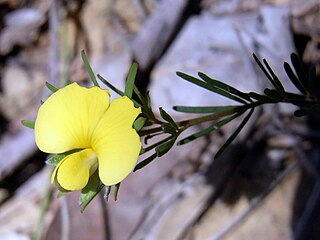
Gompholobium glabratum, commonly known as dainty wedge-pea, is a species of flowering plant in the family Fabaceae and is endemic to south-eastern continental Australia. It is a low-lying or ascending shrub with pinnate leaves that have five to seven leaflets, and yellow and green or greyish flowers.

Isopogon asper is a species of plant in the family Proteaceae and is endemic to the south-west of Western Australia. It is a low shrub with crowded pinnate leaves and flattened spherical heads of glabrous pink flowers.
Persoonia biglandulosa is a species of flowering plant in the family Proteaceae and is endemic to the south-west of Western Australia. It is an erect, spreading or low-lying shrub with smooth bark, linear leaves and bright yellow flowers in groups of between eight and twenty-five on the ends of branches.
Petrophile chrysantha is a species of flowering plant in the family Proteaceae and is endemic to southwestern Western Australia. It is a small shrub with crowded, sharply-pointed, pinnately-divided leaves, and oval heads of hairy, cream-coloured to dark yellow flowers.
Petrophile clavata is a species of flowering plant in the family Proteaceae and is endemic to southwestern Western Australia. It is a shrub with curved, needle-shaped, sharply-pointed leaves and spherical heads of hairy, cream-coloured to very pale yellow flowers.
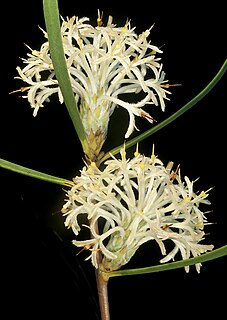
Petrophile heterophylla, commonly known as the variable-leaved conebush, is a species of flowering plant in the family Proteaceae and is endemic to southwestern Western Australia. It is a shrub with variably shaped, sometimes pinnately-divided leaves, and oval heads of silky-hairy, yellow to cream-coloured flowers.

Petrophile misturata is a species of flowering plant in the family Proteaceae and is endemic to southwestern Western Australia. It is a shrub with simple and pinnate, needle-shaped leaves and spherical heads of hairy, dull yellow flowers.

Petrophile recurva is a species of flowering plant in the family Proteaceae and is endemic to south-western Western Australia. It is an erect, many-branched shrub with needle-shaped, sharply-pointed leaves, and spherical heads of hairy pale yellow or cream-coloured flowers.
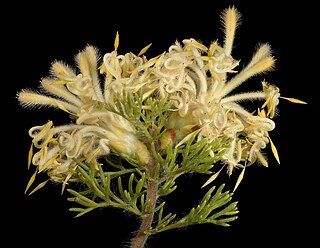
Petrophile serruriae is a species of flowering plant in the family Proteaceae and is endemic to southwestern Western Australia. It is a shrub with crowded, pinnate, needle-shaped, sharply-pointed leaves, and oval heads of silky-hairy yellow, greyish mauve to pink flowers.

Petrophile striata is a species of flowering plant in the family Proteaceae and is endemic to southwestern Western Australia. It is a shrub with pinnate or bipinnate, striated, sharply-pointed leaves, and oval heads of silky-hairy yellow, creamy-yellow or cream-coloured flowers.
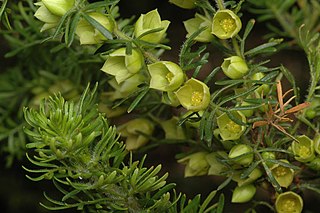
Boronia tetrandra, commonly known as yellow boronia, is a plant in the citrus family, Rutaceae and is endemic to Western Australia. It is a spreading or erect shrub with hairy stems, pinnate leaves and greenish cream to yellow or reddish brown, cup-shaped, four-petalled flowers.
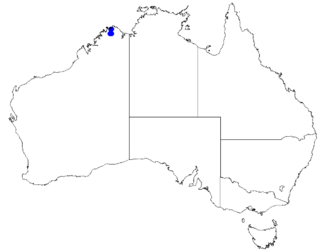
Boronia kalumburuensis is a plant in the citrus family Rutaceae and is endemic to the Kalumburu area of Western Australia. It is an erect or sprawling shrub with many branches, pinnate leaves and white to pink four-petalled flowers with the sepals longer and wider than the petals.
Gompholobium aspalathoides is a species of flowering plant in the family Fabaceae and is endemic to eastern Australia. It is an erect, more or less glabrous shrub with trifoliate leaves with linear to narrow elliptic leaflets, and yellow pea-like flowers.

Gompholobium capitatum, commonly known as yellow pea, is a species of flowering plant in the family Fabaceae and is endemic to the south-west of Western Australia. It a slender, erect or ascending shrub with pinnate leaves and yellow flowers.
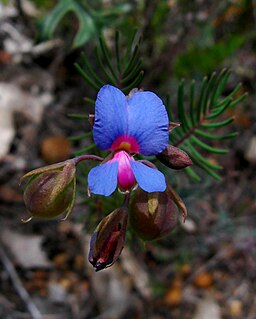
Gompholobium cyaninum is a species of flowering plant in the family Fabaceae and is endemic to the south-west of Western Australia. It is an erect to straggling shrub with pinnate leaves and blue, purple and red, pea-like flowers.
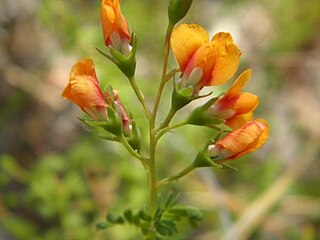
Gompholobium foliolosum is a species of flowering plant in the family Fabaceae and is endemic to eastern Australia. It is an erect shrub with pinnate leaves and orange-red, pea-like flowers.
Gompholobium gairdnerianum is a species of flowering plant in the family Fabaceae and is endemic to the far west of Western Australia. It is an erect, slender, multistemmed shrub with yellow, pea-like flowers.














